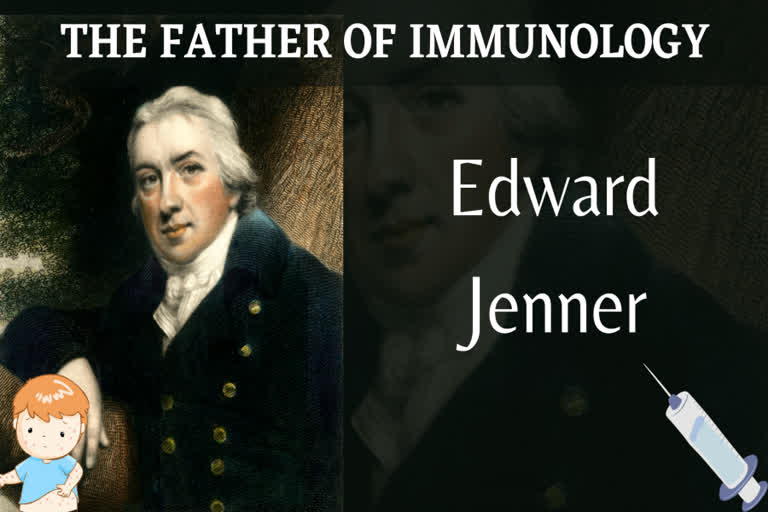Hyderabad: The father of immunology, Edward Jenner was born on 17 May 1749 in Berkeley, Gloucestershire. From childhood, Jenner had shown an interest in natural history and had collected fossils and nests. About 1812–14 Jenner was a member of the Barrow Hill Club, a group of friends interested in geology.
Edward Jenner and the history of smallpox and vaccination
- In 1796, he carried out his now-famous experiment on eight-year-old James Phipps. Jenner inserted pus taken from a cowpox pustule and inserted it into an incision on the boy's arm.
- He was testing his theory, drawn from the folklore of the countryside, that milkmaids who suffered the mild disease of cowpox never contracted smallpox, one of the greatest killers of the period, particularly among children.
- Jenner subsequently proved that having been inoculated with cowpox Phipps was immune to smallpox.
- He submitted a paper to the Royal Society in 1797 describing his experiment but was told that his ideas were too revolutionary and that he needed more proof. Undaunted, Jenner experimented on several other children, including his own 11-month-old son.
- In 1798, the results were finally published and Jenner coined the word vaccine from the Latin name for cow 'vacca'.
- Jenner was widely ridiculed. Critics, especially the clergy, claimed it was repulsive and ungodly to inoculate someone with material from a diseased animal.
- A satirical cartoon of 1802 showed people who had been vaccinated sprouting cow's heads. But the obvious advantages of vaccination and the protection it provided won out, and vaccination soon became widespread. Jenner became famous and now spent much of his time researching and advising on developments in his vaccine.
Early life and marriage
Only five of Edward's siblings survived childhood, and he was named after a brother who died in April 1749 aged five. Edward was orphaned at age 5 and went to live with his older brother who looks after his further education.
On his return to Berkeley in 1772 Jenner set up in general practice, living at first with his brother Stephen after completing his partnership under John Hunter. Hunter was not only one of the most famous surgeons in England, but he was also a well-respected biologist, anatomist, and experimental scientist.
In 1785 Jenner bought Chauntry Cottage (The Chantry), Berkeley, and on 6 March 1788, he married Catherine Kingscote of Kingscote near Berkeley. They had three children: Edward, Catherine and Robert Fitzharding. Their family life was happy, marred only by the death of young Edward from tuberculosis, and the chronic ill-health of Jenner's wife, caused by the same disease.
Also Read:Apple to reduce Face ID scanner sensor size for iPhone 13: Report
Jenner's other medical and scientific work
- From childhood, Jenner had shown an interest in natural history and had collected fossils and nests. Later his fossil specimen of a plesiosaurus was the first to be identified in Britain, and he was made an honorary member of the Geological Society in 1809.
- About 1812–14 Jenner was also a member of the Barrow Hill Club, a group of friends interested in geology.
- He also undertook other minor projects on topics as diverse as manures, distemper in dogs, and tuberculosis, and his general interests in natural history were acknowledged in 1798 by his election to the fellowship of the Linnean Society.
- In 1784, soon after both the Montgolfiers' pioneering flight and the first flight in Britain, Jenner was involved in the flight of an unmanned balloon.
- He also made various observations on anatomy and physiology which were incorporated into John Hunter's papers.
- In 1783 he published an improved method for preparing pure emetic tartar (potassium antimony tartrate) by recrystallization, and in 1799 Caleb Parry acknowledged Jenner as the first to associate the clinical features of angina pectoris with its underlying anatomical changes.
- Jenner's interest in ornithology merits special mention. In his free time, he began to research cuckoos and after many hours of observation as well as dissection, he came to the conclusion that it is the young newly-hatched cuckoo that pushes the eggs out of the host’s nest, a theory that went against the traditional belief at the time that the adult cuckoo was responsible.
- Jenner started the work on bird migration which was completed just before his death. At a period when some still believed that birds hibernated, he helped to confirm that they did migrate. He also showed, by dissection, that this behavior was connected to changes in the reproductive system and not due to climatic changes or to food shortage and in the last year of his life, presented a paper on the “Observations on the Migration of Birds” to the Royal Society.
